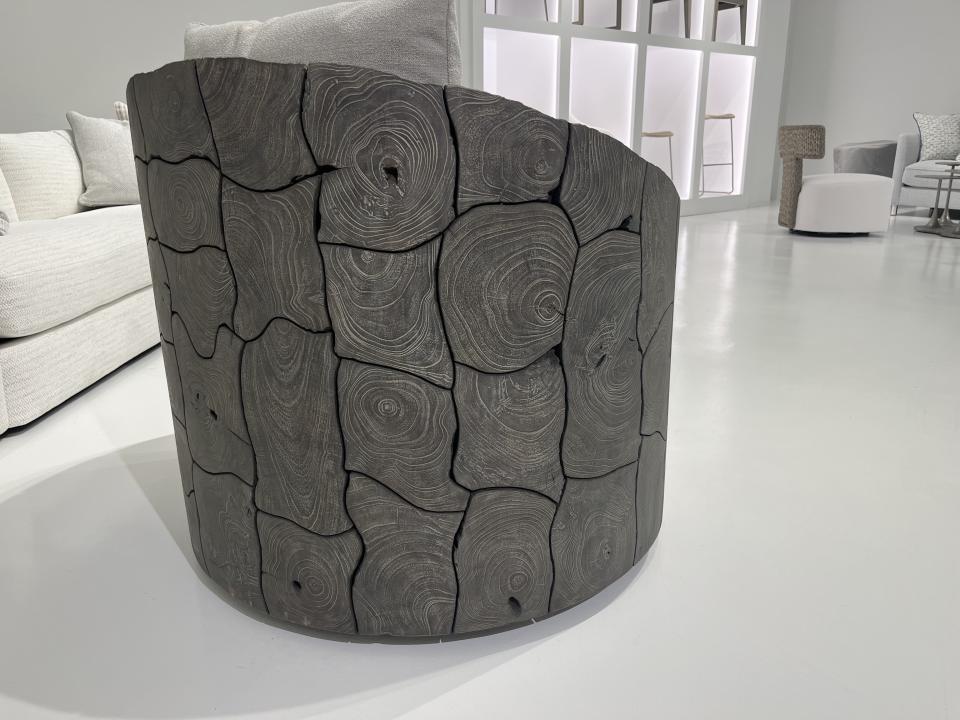From Craftivism to Sustainable Wellness: Four Home Trends to Watch

At the spring High Point Market — the semiannual furnishings and decor trade show held in High Point, North Carolina — trend forecasters, interior designers and furnishings makers gathered to offer a peek into the future of home design. Throughout the market’s showrooms, the impact of micro and macro trends could be felt in the colors, textures and materials of product introductions.
Among the many trends taking shape at the market, these four stand out as potentially the most influential in how home design will evolve over the coming seasons.
More from WWD
Updated Traditional
As a return to nostalgia and more traditional looks continues to build in home design, the trend evolves with classic silhouettes getting a refresh via new finishes, fabrics or materials.
“An overall sentiment of nostalgia is permeating the consumer lifestyle, driven by the comforting reassurance of the past while the future feels uncertain,” said Samantha Noonan, design account executive at Sherwin Williams. “Tried-and-true classics, updated reissues and revived iconic ranges have been a key design direction over the past few seasons and will continue to drive the retro aesthetic.”
This fresh take on the classics showed up in several High Point showrooms, such as outdoor brand Brown Jordan, which paired its 1967 Calcutta collection with fabrics from the company’s Swing Time line with Schumacher and fresh finishes such as a vibrant daffodil yellow. Elsewhere, Brown Jordan’s famed Cantan chair got an eye-popping refresh with Barbie-pink straps, and its Walter Lamb rockers — which mark their 75th anniversary this year — felt current with new finishes and rope colors.
Craftivism
The focus on craftsmanship and a slower, more artisanal approach to design expands to incorporate more of a social and environmental consciousness, dubbed “craftivism.” This movement taps into sustainability and fair trade practices, taking them a step further to promote ideas to better the world.
“Thanks to a new generation of artisans, craft is undergoing a renaissance,” Noonan said. “From embroidery to ceramics, these hand-crafted arts are shedding their association with stuffy heritage and increasingly crossing into the world of global activism, addressing concerns of everything from sustainability to consumerism, the environment to gender politics, cultural appropriation to gun crime.”
Restorative and regenerative design practices play into this movement, as well, with a focus on local producers.
“We’re seeing cotton, wool and hemp sourced from regenerative farms, really having that more sustainable story,” said Jaye Anna Mize, vice president, home and lifestyle, at trend forecasting agency Fashion Snoops. “And the environmental impact significantly lessens with local procurement.”
Raw Organic
Concepts of sustainability and biophilic design contribute to this trend of raw, organic materials, shapes and textures in furniture and fabrics.
“We’re seeing that consumers want things to feel a little bit untamed and wild and unruly, particularly when we’re going to a lot of the higher-end design festivals like Milan Design Week and Maison et Objet,” Mize said. “We’re seeing a lot of composites or delicate decays come to the forefront as designers are experimenting, and it can feel really elevated and lovely.”
The trend showed up in multiple showrooms, such as Bernhardt, which showed off a table and chairs made with individual hand-carved pieces of teak, assembled together like a puzzle. The waving, concentric growth rings on each slice of wood add to the natural look of the pieces.
Netherlands-based Eichholtz — which revealed during market that it will partner with The Metropolitan Museum of Art for a furnishings collection set to debut in October — filled its showroom with organic forms, particularly in stone occasional tables and decor pieces.

“We increased our use of stone — a lot of travertine and alabaster — and it’s all natural stone, so you see the different variations in the veining,” said Alyssa Abrams, marketing director of Eichholtz. “We’re playing a lot with our silhouettes — European design is a little more linear and streamlined, so we’ve softened up a bit to be more freeform and organic.”
Sustainability and Wellness
While sustainability and wellness have been trending in design for a few seasons, the individual concepts have only recently begun to converge, playing into the pandemic-fueled desire for safety and relaxation at home.
“Home as a sanctuary will continue to be a priority in design,” Noonan said. “And healing and haptic materials, mood-boosting colors and earthy textures will connect us back to nature.”
One of the biggest places this trend plays out is in the bedroom, as evidenced by luxury mattress maker Saatva’s assortment at High Point Market, which highlighted its beds made with organic cotton, sustainably sourced natural latex and eco-friendly foam. Mize said bedding and textile companies have been at the forefront of the merger of sustainability and wellness in the home.
“Textiles are really leading in sustainability and wellness — people don’t want to sleep on chemicals,” she said. “And textile companies are leading the charge to get rid of formaldehyde and PFAS.”
Mize said many of these trends have their roots in fashion and beauty, making them practically inevitable to find their place in the home.
“A lot of fashion companies are leading the forefront, which is how we know it will also land in home,” she said. “How fashion trickles into home is one of the biggest indicators of the strength of a trend.”
Best of WWD

